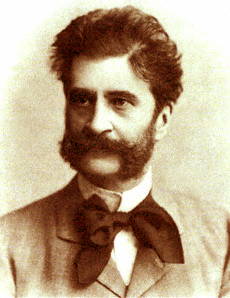

Johann Strauss II (1825 -1899) composed Emperor Waltz in 1889. Strauss was an Austrian composer, conductor and violinist, and was considered to be the leading European composer of dance music of his time. Johann was a member of the famous Strauss family, and they were particularly noted for their waltz music. The waltz was the most popular ballroom dance form in the 19th century, and the Strauss family played a prominent role in Vienna's social scene, composing and performing waltzes and other dance music for dance establishments and social events. Members of the Strauss family were internationally renowned for their Strauss Orchestra performances (this orchestra was begun by Johann I, the senior member of the Strauss family). Johann Strauss II became the most famous member of the musical Strauss family, and he was awarded the nickname "The Waltz King." [17]
The waltz form, a dance with a triple meter, originated in rural dance music, and Johann Strauss I and a fellow-musician, Joseph Lanner, expanded and formalized this rural dance form. Johann Strauss II took the waltz form begun by his father and Lanner a step further, and added new melodic, harmonic and structural dimensions. Johann Strauss II eventually elevated the waltz form beyond the ballroom and the realm of popular music, to the level of art music suitable for the concert hall. The term Viennese Waltz is sometimes used to describe the waltzes which emerged from Vienna during this time, a term which not only refers to the fully developed form of the waltz, but also to stylized elements in performing the waltz such as a subtle use of rubato and a slight anticipation of the second beat. [18]
Johann Strauss II composed Emperor Waltz (Kaiser-Walzer) in honor of the Austrian Emperor, Franz Josef's visit to the German Kaiser, Wilhelm II. Johann conducted the premier of this piece at the newly-opened Berlin Königsbau concert hall in 1889. [19]
TECHNIQUE TIPS: This arrangement of the Emperor Waltz has the flowing triple meter of a waltz, with a strong ONE-two-three pulse in each measure. Use smooth, full bows to maintain the momentum and rhythm of this waltz.
© Copyright 2025 RK Deverich. All rights reserved.
Although this online violin class is provided free of charge, all rights are reserved and this content is protected by international copyright law. It is illegal to copy, post or publish this content in any form, and displaying any of this material on other websites, blogs or feeds is prohibited. Permission is given for individual users to print pages and perform music from this website for their personal, noncommercial use.